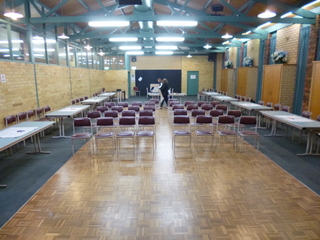This is not truly “open space” for a number of reasons but makes use of some similar techniques. It is a very useful process that can be thrown together fairly quickly when you have something important to be debated and acted upon and lots of people to discuss it with. Our process was carried out with the good people of Permaculture Sydney West, set up by Danielle wheeler (Permaculture Educator) and facilitated by Greg Meyer (business consultant and PSW President).
One complaint levelled against some areas of Permaculture is that there is an excess of talk and a lack of action. We wanted to dream big but make down-to-earth plans that we could carry out realistically, our subject: developing a sustainable food Plan for Western Sydney within which Permaculture Sydney West could play part. This was to be run at one of our usual Monday night meetings which gave us about an hour and a half to come up with something meaningful, or at least start the process.
The hall was set up in our standard fashion, with ranks of chairs facing forward for a presentation (that’s why it is not totally “open space”) but with tables all around the outside. Once the usual stuff was out of the way Danielle gave a presentation that gave some background and helped to set the context and scope of what were going to do. She talked about some issues with our current food system and what some alternative food production and distribution models were and at the end, what questions we would be answering to help us develop the bones of the strategy.
Once the scene was set, Greg took over to facilitate the process, telling us that –
- There were six tables, each with a facilitator or pair of co-facilitators
- Everyone in the room was to pick a table and go to it
- We would work through the series of questions, giving each one about 5 minutes or so
- Each person would give their ideas about the question which would be recorded by the facilitator on butcher paper.
- Once discussions were complete, there would be a round-robin where each table would report back a summary of what they came up with, one question at a time, to the group.
- Notes would be taken during this process and consolidated for all the participants
- Right at the end, some actions would be decided and people could commit to being part of a particular action.
At that point the facilitators each went to their table and the questions which we were to consider were handed out and as well as being projected up onto the screen:
- Vision: what will sustainable food look like for Western Sydney? What are our aims and goals?
- People: who do we need to make this happen? What skills will we need? What can you do to help?
- Strategy: what are our priorities and how do we move from talk to action?
- Results: how will we measure success?
Once this had been done, discussion commenced, the idea was that we would give each of the questions 5 minutes discussion, while the facilitator kept the discussion on track, gave everyone an opportunity to speak and wrote down the salient points. The small amount of time for discussion limits the depth, but it is surprising what half a dozen people of varying experience can come up with in a short time. The difficulty can be limiting the contribution of the more forceful participants and making sure the more retiring ones get their say as well.
With all of the original work done 10 minutes was allocated for the participants to wring the juice out of (ie summarise) what we had come up with, not an easy thing to do while keeping all the participants happy that their particular axe was fully ground. It was also important not to let any new stuff creep in while summarising the existing work to avoid confusion. Once the summaries were worked out each table delivered theirs while the salient points were typed directly into a computer which displayed the results on the screen, so that doubling up answers was kept to a minimum.
It was generally agreed by everyone that training and education would be important to enable Western Sydney to grow enough food to feed itself so there was a 10 minute brainstorm on the skills which would be required. The results of the brainstorm were also recorded on the computer and projected on the screen.
At the end some actions were put up on the screen which came up during the course of the discussions and there was an opportunity for all of the participants to nominate themselves as being interested in and willing to contribute to. All of the butcher paper was also collected to allow a more detailed summary of the proceedings to be drawn up.
Some of the answers we came up with included –
Vision
Feeding ourselves starting at home; Community sharing; Limiting waste; Generational equity; Giving back, diversity of production; Doing, observing, grassroots, school involvement; Reduced food miles; Use vacant space; Directory of local producers; Backup food security plan; Quality food organic, non-GMO; More community gardens; Work with farmers, sharing experience, improve sustainable growing practices; Eco-villages; Local distribution points; Diverse, local, organic, happy; Affordable, economically sustainable.
People
Everyone’s invited; Advocacy; Leaders, facilitators; Subject matter experts; Tradespeople; Councils involved; Schools, universities, community groups; Networking as broad as possible; Refugees, other cultures; Supporting older people staying in their homes: land share; Growers and seed savers
Strategy
Create businesses for people involved – allows people to make a living; Trained street and unit leaders; Sustainable centre: go-to place for meetings, education, etc; Template to turn community centres into sustainable centres; Working examples in urban centres; Contact community members; Make land and water available eg Govt, land share, Sydney basin Trust; Use vacant private land; Simple, easy to join, easy to do; Start a co-op/buying group ;Multiple layers as back-up/ web for resilience; Distribution points; Year round food production group; Blueprint and template strategies; Curriculum for schools; Matching people by time and resources; Lobby govt for sustainable land use, sustainable food/advocacy; Lobby against urban sprawl and loss of greenspace; Leaflets: start in streets. Promotion committee; Access migrant communities; Connect with other groups eg ATA; Train commercial farmers; Engage councils AFTER gaining critical mass; Engage local businesses; Use corporate social responsibility






